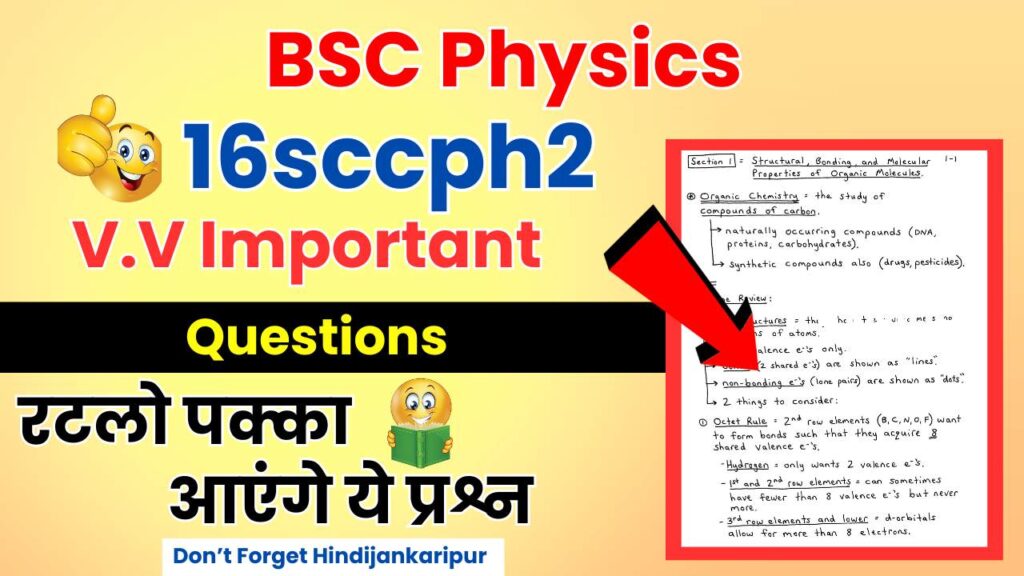Hello friends, do you want to know about 16sccph2 bsc physics important questions? Friends, welcome to this article, we will tell you all about the bsc physics Important Question.
Friends, we have collected all the important questions mentioned in this article from the 16sccph2 bsc physics important questions. Friends, all these questions are very important.

As you know BSC Physics is a very interesting subject, so in this article we have shared 16sccph2 bsc physics important questions.
Which will help you in studying, if you memorize these Important Questions mentioned in this article, then you can understand upto 60% syllabus, so friends, Read complete list of 16sccph2 bsc physics important questions, till the end.
16sccph2 Bsc Physics Important Questions

What is the concept of ‘free fall’ and how is it related to the theory of gravity?
Free fall refers to the motion of an object under the influence of gravitational force only. It is a key concept in understanding gravity and its effects on objects.
What is the phenomenon of radioactivity and what are its types?
Radioactivity is the spontaneous emission of particles or radiation from the nucleus of an unstable atom. The main types are alpha, beta, and gamma radiation.
What are the principles of quantum entanglement?
Quantum entanglement is a phenomenon where particles become interconnected and the state of one particle instantly influences the state of another, regardless of distance.
How does a Geiger-Müller counter work to detect radioactive decay?
A Geiger-Müller counter detects radioactive decay by ionizing radiation, which creates ion pairs in a gas-filled tube, leading to a measurable electric pulse.
What is the significance of the Compton effect in quantum mechanics?
The Compton effect demonstrates the particle nature of light by showing how X-rays scatter off electrons, resulting in a change in wavelength.
Explain the principle of superfluidity.
Superfluidity is a phase of matter where a fluid can flow without viscosity, allowing it to move through tiny pores without losing kinetic energy.
What is the principle of wave function collapse in quantum mechanics?
Wave function collapse occurs when a quantum system transitions from multiple possible states to a single definite state upon measurement.
How does a synchrotron work and what is it used for?
A synchrotron accelerates charged particles to high speeds using magnetic fields and is used in various applications, including medical imaging and materials science.
What is the concept of ‘quantum tunneling’?
Quantum tunneling is a phenomenon where particles pass through a potential barrier that they classically shouldn’t be able to cross.
How are the principles of physics applied in the design and operation of a microwave oven?
Microwave ovens use electromagnetic waves to agitate water molecules in food, producing heat through dielectric heating.
What is meant by ‘quantum decoherence’ in quantum mechanics?
Quantum decoherence is the process by which a quantum system loses its quantum properties due to interaction with its environment, leading to classical behavior.
How does a spectrometer work and what is it used for?
A spectrometer measures the properties of light over a specific portion of the electromagnetic spectrum, used in chemical analysis and astronomy.
What is the principle of ‘wave-particle duality’?
Wave-particle duality is the concept that particles, such as electrons and photons, exhibit both wave-like and particle-like properties.
What is the phenomenon of ‘pair production’ in particle physics?
Pair production occurs when a photon converts into an electron-positron pair in the presence of a strong electromagnetic field.
What are the principles of ferromagnetism and paramagnetism?
Ferromagnetism is the alignment of magnetic moments in the same direction, while paramagnetism is the alignment of magnetic moments in the presence of an external magnetic field.
How does the concept of ‘centripetal force’ apply to the motion of planets?
Centripetal force is the inward force required to keep an object moving in a circular path, crucial for understanding planetary orbits.
What is the ‘Casimir effect’ in quantum field theory?
The Casimir effect is a physical force arising from the quantum vacuum fluctuations between two closely spaced conducting plates.
How does the principle of ‘hysteresis’ apply to magnetic materials?
Hysteresis in magnetic materials refers to the lag between changes in magnetization and the external magnetic field, important in designing magnetic storage devices.
What is the ‘Hawking radiation’ associated with black holes?
Hawking radiation is theoretical radiation predicted to be emitted by black holes due to quantum effects near the event horizon.
How are the principles of physics applied in the design and operation of a GPS (Global Positioning System)?
GPS uses principles of relativity and electromagnetic wave propagation to provide accurate location data by triangulating signals from satellites.
What is the phenomenon of ‘sonoluminescence’?
Sonoluminescence is the emission of short bursts of light from imploding bubbles in a liquid when excited by sound.
How does a cathode ray tube work and what is it used for?
A cathode ray tube generates images by directing electron beams onto a phosphorescent screen, used in older television and computer monitors.
Related Posts
Bsc 3rd Year Practical Files: Physics, Chemistry, Zoology, Botany
Bsc 1st Year Practical Files: Physics, Chemistry, Zoology, Botany
BSC 3rd year PHYSICS important questions 2024
The above list covers the important questions that may be important for computer exam. By preparing well for these questions, students can cover a large part of their syllabus and perform better in the exam.
We hope that with the help of this article you have got information about 16sccph2 bsc physics important questions.
Friends, how did you like this post, please tell us in the comment section and if you have any questions, feel free to ask us in the Comment Box. If you find this post useful, please share it with others.